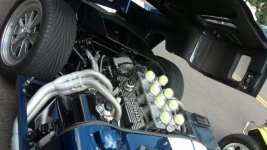Jay Leno owns an 87, a predecessor of the 603:
http://www.jaylenosgarage.com/video/tatra-t87/277881/
Tatra was known for having developed very aerodynamic cars in the 1930s with rear mounted, air-cooled engines. In fact Tatra accused Volkswagen of having based the design of the Beetle on the prototype Tatra V570. See
http://en.wikipedia.org/wiki/Tatra_V570 . Eventually they settled out of court.
Tatra, being a Czechoslovakian company, was forced to produce only a certain number of cars under the planned economy of the communist Czechoslovakian state after the Second World War. Skoda was 'given' exclusive licence to build passenger cars after the war but the Tatra employees fought with the government to be allowed to continue to produce cars, in addition to the state-mandated production of trucks. The 603 was the second post-war product they made, produced from the '50s until the mid-'70s. It was replaced by the 613, essentially a heavily re-engineered version of the 603 with a more contemporary body. After the Cold War ended Tatra made one last passenger car, the 700. Production only lasted a couple years and few cars were sold.
Tatra now only builds trucks, focusing on the production of heavy-duty off-road models for the construction, mining, forestry and oil & gas industries; they build everything from 4x2 to 4x4, 6x6, 8x8 and even 10x10 models. They're the biggest independent automotive manufacturer left in the Czech Republic (Skoda having been gobbled up by Volkswagen, of course).
It's sad that Tatra was crushed under the communist regime. Unlike most Eastern Bloc cars Tatras were built to very high standards, were of excellent quality and had very innovative designs. By comparison Skodas were plebeian, and most cars from other Bloc countries were cheap knockoffs or licenced copies of other manufacturers' cars (Ladas and FSOs from Russia and Poland were Fiats, Dacias from Romania were Renaults, Moskvitches were mostly copies of Opels, older ZILs were almost exact copies of Packards, etc.).


















